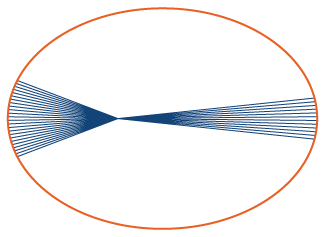| << Chapter < Page | Chapter >> Page > |
The graph of where ℓ is a piecewise linear function, is shown here.
![A graph of a function that goes through the points (0, 0), (1, 1), (2, 0), (3, -1), (4.5, 0), (5, 1), and (6, 2). The area under the function and over the x axis over the intervals [0, 2] and [4.5, 6] is shaded. The area over the function and under the x axis over the interval [2, 2.5] is shaded.](/ocw/mirror/col11965_1.2_complete/m53632/CNX_Calc_Figure_05_03_205.jpg)
a. ℓ is positive over and and negative over b. It is increasing over and and it is constant over and c. Its average value is
In the following exercises, use a calculator to estimate the area under the curve by computing T 10 , the average of the left- and right-endpoint Riemann sums using rectangles. Then, using the Fundamental Theorem of Calculus, Part 2, determine the exact area.
In the following exercises, evaluate each definite integral using the Fundamental Theorem of Calculus, Part 2.
In the following exercises, use the evaluation theorem to express the integral as a function
In the following exercises, identify the roots of the integrand to remove absolute values, then evaluate using the Fundamental Theorem of Calculus, Part 2.
Suppose that the number of hours of daylight on a given day in Seattle is modeled by the function with t given in months and corresponding to the winter solstice.
Suppose the rate of gasoline consumption in the United States can be modeled by a sinusoidal function of the form gal/mo.
a. The average is since has period 12 and integral 0 over any period. Consumption is equal to the average when when and when b. Total consumption is the average rate times duration: c.
Explain why, if f is continuous over there is at least one point such that
Explain why, if f is continuous over and is not equal to a constant, there is at least one point such that and at least one point such that
If f is not constant, then its average is strictly smaller than the maximum and larger than the minimum, which are attained over by the extreme value theorem.
Kepler’s first law states that the planets move in elliptical orbits with the Sun at one focus. The closest point of a planetary orbit to the Sun is called the perihelion (for Earth, it currently occurs around January 3) and the farthest point is called the aphelion (for Earth, it currently occurs around July 4). Kepler’s second law states that planets sweep out equal areas of their elliptical orbits in equal times. Thus, the two arcs indicated in the following figure are swept out in equal times. At what time of year is Earth moving fastest in its orbit? When is it moving slowest?

A point on an ellipse with major axis length 2 a and minor axis length 2 b has the coordinates
a. b.
As implied earlier, according to Kepler’s laws, Earth’s orbit is an ellipse with the Sun at one focus. The perihelion for Earth’s orbit around the Sun is 147,098,290 km and the aphelion is 152,098,232 km.
The force of gravitational attraction between the Sun and a planet is where m is the mass of the planet, M is the mass of the Sun, G is a universal constant, and is the distance between the Sun and the planet when the planet is at an angle θ with the major axis of its orbit. Assuming that M , m , and the ellipse parameters a and b (half-lengths of the major and minor axes) are given, set up—but do not evaluate—an integral that expresses in terms of the average gravitational force between the Sun and the planet.
Mean gravitational force =
The displacement from rest of a mass attached to a spring satisfies the simple harmonic motion equation where is a phase constant, ω is the angular frequency, and A is the amplitude. Find the average velocity, the average speed (magnitude of velocity), the average displacement, and the average distance from rest (magnitude of displacement) of the mass.

Notification Switch
Would you like to follow the 'Calculus volume 2' conversation and receive update notifications?